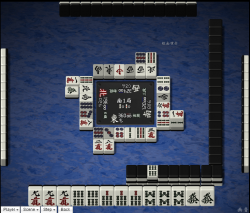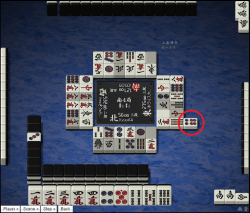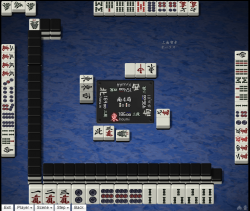Furiten: Difference between revisions
No edit summary |
No edit summary |
||
| Line 34: | Line 34: | ||
It is important to bear furiten in mind when developing a hand. Frequently, if a hand gets to tenpai and is furiten, then the hand was inefficiently developed. This is not always the case, however, as a player can make a correct decision but still be in furiten. | It is important to bear furiten in mind when developing a hand. Frequently, if a hand gets to tenpai and is furiten, then the hand was inefficiently developed. This is not always the case, however, as a player can make a correct decision but still be in furiten. | ||
A common reason for furiten is when a player is in tenpai with an open hand, but it has no guaranteed yaku. In these | A common reason for furiten is when a player is in tenpai with an open hand, but it has no guaranteed yaku. In these cases, the hand will only gain yaku if it draws a certain winning tile. If a different winning tile is drawn, the hand will have no yaku, and is thus forced to discard its own winning tile - entering furiten. This most commonly occurs with: | ||
*A [[shanpon]] wait, with one tile completing a [[yakuhai]] triplet, and the other having no yaku. | *A [[shanpon]] wait, with one tile completing a [[yakuhai]] triplet, and the other having no yaku. | ||
*A [[ryanmen]] wait on 14 or 69 on a hand that would otherwise complete [[tanyao]]. | *A [[ryanmen]] wait on 14 or 69 on a hand that would otherwise complete [[tanyao]]. | ||
| Line 57: | Line 57: | ||
The primary purpose of the rule is to prevent a player from targeting a later player in the turn order. Once a player sees a tile discarded, they know that they can follow with the same tile and it will be safe for that turn. | The primary purpose of the rule is to prevent a player from targeting a later player in the turn order. Once a player sees a tile discarded, they know that they can follow with the same tile and it will be safe for that turn. | ||
A player may deliberately skip a win, entering temporary furiten in the process. This is often done after [[situational analysis|point standing analysis]]: | A player may deliberately skip a win, entering temporary furiten in the process. This is often done after [[situational analysis|point standing analysis]], such as: | ||
*When a player is close to [[tobi|bankrupting]], a player in 1st may want to target them in order to end the game faster. | |||
*When close to [[oorasu|all last]], a player may need to ron a specific player to [[gyakuten|rise up in rank]]. | |||
Temporary furiten can also be entered by a player who does not have a guaranteed yaku, as described above. Otherwise, a player may mistakenly enter furiten if they don't know their waits correctly. | |||
Rarely, some rulesets [[Rule variations#Furiten|vary the rules]] by allowing a tile call made by another player to cancel temporary furiten. | Rarely, some rulesets [[Rule variations#Furiten|vary the rules]] by allowing a tile call made by another player to cancel temporary furiten. | ||
Revision as of 14:44, 26 June 2024

While a player's hand is in furiten 「振聴」, the player cannot declare a win on another player's discard (i.e., they cannot ron). They are still allowed to win with their own draw (tsumo), assuming the hand is valid.
The most common form of furiten is with discards: if any tile a player's hand could have won off had been discarded before, it is furiten. A hand may also enter furiten when a player skips a win.
This rule is often used for defense purposes to determine safe tiles: any tile a player discards is 100% safe against that player.
Rule overview
A hand in tenpai is in furiten in any of the following scenarios:
- Discard furiten: When at least one winning tile had been discarded before, the hand enters furiten. This applies even if the hand couldn't actually win if it got that tile (due to lacking yaku). A does not have to be in your discard pile to invoke furiten; if an opponent called a tile, it will still trigger fuirten.
- Permanent furiten: After declaring riichi, if the first winning tile is skipped, the hand permanently enters furiten.
- Temporary furiten: When not in riichi, when a winning tile is skipped, the hand enters temporary furiten. This furiten lasts until the player's next draw.
While in furiten, the hand is unable to call ron upon a discard. However, it is still winnable via self-draw, assuming the hand has valid yaku.
Note: If a hand is in furiten, it is unable to win off any player's discard, regardless of which tile caused the furiten. For example, if your hand is waiting to win with 2p and 5p, and you had discarded 2p before, you are unable to win off an opponent's 5p.
Discard furiten
The most common case of furiten involves a player's own discard. If a player's own winning tile had been discarded before, then their hand enters furiten.
You can tell what tiles a player discarded by looking at their discard pile, and looking at the rotated tiles in other players' tile calls. This leads to the most basic strategy to avoid dealing into a player's hand: tiles they have already discarded are guaranteed to be safe against a ron call from that player.
It is important to bear furiten in mind when developing a hand. Frequently, if a hand gets to tenpai and is furiten, then the hand was inefficiently developed. This is not always the case, however, as a player can make a correct decision but still be in furiten.
A common reason for furiten is when a player is in tenpai with an open hand, but it has no guaranteed yaku. In these cases, the hand will only gain yaku if it draws a certain winning tile. If a different winning tile is drawn, the hand will have no yaku, and is thus forced to discard its own winning tile - entering furiten. This most commonly occurs with:
- A shanpon wait, with one tile completing a yakuhai triplet, and the other having no yaku.
- A ryanmen wait on 14 or 69 on a hand that would otherwise complete tanyao.
These type of cases are known as atozuke.
Finally, a player considering a double riichi should carefully inspect their hand before discarding; if they had a complete hand to begin with, then being in furiten will add insult to the injury of having [passed] on a tenhou or chiihou tsumo.
A hand can escape this type of furiten by changing its waits.
Example tenpai hand
This hand waits on three different tiles. If the player has a 2-pin in their discard pile, then the hand is in furiten and may not win by ron on any tile. Even if a 5-pin or 8-pin gets discarded by an opponent, ron may not be called.
Temporary furiten

Any player in tenpai has the option to ignore a winning tile. By declining a call for ron, the player then becomes temporarily furiten until their next discard. This is called temporary furiten, because it only lasts for 1 turn. This applies to discarded tiles, as well as tiles used to create a shouminkan.
The primary purpose of the rule is to prevent a player from targeting a later player in the turn order. Once a player sees a tile discarded, they know that they can follow with the same tile and it will be safe for that turn.
A player may deliberately skip a win, entering temporary furiten in the process. This is often done after point standing analysis, such as:
- When a player is close to bankrupting, a player in 1st may want to target them in order to end the game faster.
- When close to all last, a player may need to ron a specific player to rise up in rank.
Temporary furiten can also be entered by a player who does not have a guaranteed yaku, as described above. Otherwise, a player may mistakenly enter furiten if they don't know their waits correctly.
Rarely, some rulesets vary the rules by allowing a tile call made by another player to cancel temporary furiten.
Permanent furiten during riichi

When a player has declared riichi, the state of temporary furiten does not expire. Therefore, if a riichi hand skips a win, it is no longer able to call ron.
The purpose of this rule is to make it easier to defend against riichi. Any tiles discarded since the declaration is safe against that riichi player.
A player in riichi never has to worry about having no yaku unless they are playing with ryanhan shibari. When ryanhan shibari, a riichi without a guaranteed second yaku may be quite dangerous due to furiten.
Strategy
Defense
The furiten rule is essential for defensive play. Any tile that would invoke furiten to a player is 100% safe against that player:
- Discard furiten: Any tile that an opponent discarded is 100% against them.
- Permanent furiten: an opponent declares riichi, any tile anyone discards (and not won off of) is 100% safe against that riichi player.
- Temporary furiten: Any tile that the player to your left has discarded this turn is 100% safe against every player for this turn only.
Suji is a technique that is related to furiten. When a tile is suji, a hand cannot have a ryanmen wait (2-sided wait; the most common type of wait) for that tile without being in furiten.
Working with furiten
Sometimes, it may be necessary to enter tenpai, even while in furiten. Often, this is the result of developing the hand and defending simultaneously.
To exit discard furiten, you can change the hand's wait so that it can no longer win off any of the discarded tiles. For example:
If the hand had discarded ![]() previously, it would be in furiten. By drawing
previously, it would be in furiten. By drawing ![]() and discarding
and discarding ![]() , it now waits on
, it now waits on ![]() and
and ![]() . Thus, the hand is no longer waiting on
. Thus, the hand is no longer waiting on ![]() , and is no longer in furiten.
, and is no longer in furiten.
Alternatively, a hand can rely on tsumo to win. With a 3-sided wait, this is feasible, and even a 2-sided furiten is strong.
Rarely, a hand in damaten can intentionally enter furiten. In this case, the hand is in tenpai, but after a winning tile is drawn, the player does not declare a win but declares riichi - immediately entering furiten. This may be done to score pinfu + mentsumo in all last.
External links
- Furiten in Japanese Wikipedia